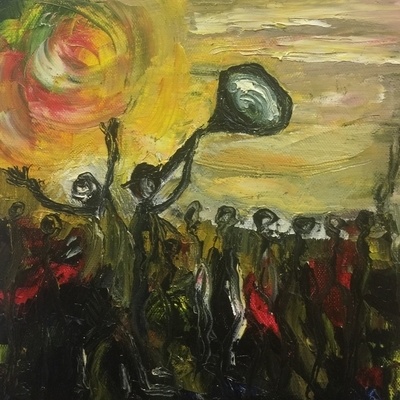Celebrate 25 years of Art with URI Alum Nixon Leger. PHOTO CREDIT: Nixon Leger
Through Feb. 24, the University of Rhode Island Providence Campus urban arts and culture program is showcasing 120 paintings created by Nixon Leger, ‘17, in “Celebrating Nixon Leger! 25 Years of Art from Haiti to Rhode Island A Solo Exhibit.”
Leger was a professional artist and teacher in his native Haiti, but when he immigrated to the United States in 2008, his art degree was not recognized. He graduated URI with a bachelor’s of fine arts in studio art and has since been featured in the University’s art galleries many times, according to Steven Pennell, the urban arts and culture program’s marketing and communications chair.
The paintings are being showcased on the first and second floors of the gallery at the Providence Campus and can be viewed on weekdays. A special gallery reception will be held on Thursday, Feb. 17 from 6-8 p.m. A virtual tour of the exhibit narrated by Pennell is also available on Pennell’s YouTube page.
Leger’s pieces largely focus on Haitian history, with paintings depicting enslavement and Haitian culture, of which music and religion are prominently featured.
“Many of them are very playful, and others are very political, dealing with how politics plays into contemporary life in Haiti and also historically has been a part of Haitian culture,” Pennell said.
A motif that appears throughout many of Leger’s paintings is the plantation leaf, or banana leaf, which Leger has called his “muse.” He said that he fell in love with them as a child in Haiti. One painting that features this motif shows two figures made of banana leaves, both playing instruments. Instead of human faces, one has a crescent moon and the other has a sun in its place. This motif earned Leger the nickname “Banana Leaf Man.” The leaves are shown in many different forms in his paintings, particularly in his depiction of the human form, in which the leaves appear as hair and other body parts, or even make up the entire figure of a person.
For Leger, these leaves represent the cycle of life and birth. This cycle is a strong theme throughout the exhibit, particularly in paintings of pregnant women.
One of the pieces of Leger’s on display is titled “The Next Generation.” In this painting, a woman is standing hunched over, carrying the weight of a man above her, who has his arms stretched out. Despite the simplicity of the work itself, there is a strong message about standing on the shoulders and backs of those before you and how they may have to suffer and experience pain for you to experience joy and access to opportunities they never could.
This carrying on of life is also shown in a side portrait of a woman with her eyes closed, a basket on her head that’s full of people upon a closer look. Drawn in her foreground are a man and woman, giving the illusion that they too are carrying this basket. It’s a beautiful piece and is among many that show groups of faceless people being carried in some way, shape or form.
Leger’s work shows great variety, from the more realistic paintings, such as a striking, colorful portrait of American jazz singer Ella Fitzgerald, to the darker, muted, more abstract works featured in his “Mutation” series. According to Pennell, these 120 paintings were done in a variety of styles, subjects and media. Leger also worked in oil, acrylic and had pieces on burlap, linen, board and canvas.
For more information on “Celebrating Nixon Leger! 25 Years of Art from Haiti to Rhode Island A Solo Exhibit,” visit the URI events page.




